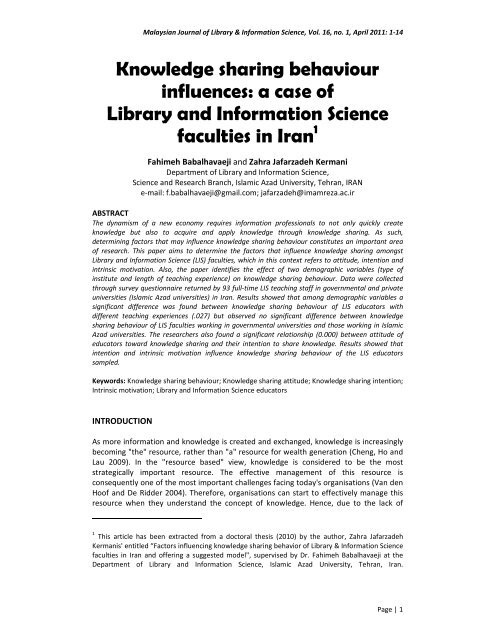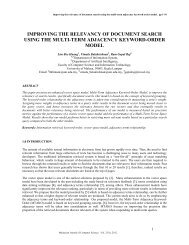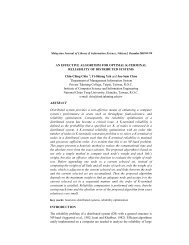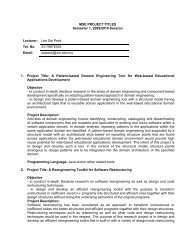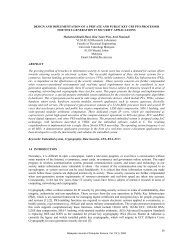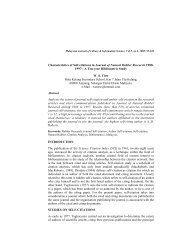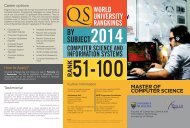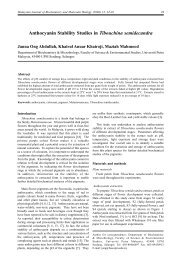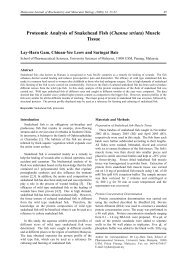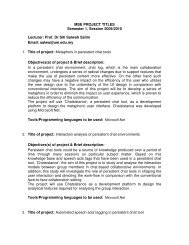Download1 - EJUM
Download1 - EJUM
Download1 - EJUM
Create successful ePaper yourself
Turn your PDF publications into a flip-book with our unique Google optimized e-Paper software.
Malaysian Journal of Library & Information Science, Vol. 16, no. 1, April 2011: 1-14Knowledge sharing behaviourinfluences: a case ofLibrary and Information Sciencefaculties in Iran 1Fahimeh Babalhavaeji and Zahra Jafarzadeh KermaniDepartment of Library and Information Science,Science and Research Branch, Islamic Azad University, Tehran, IRANe-mail: f.babalhavaeji@gmail.com; jafarzadeh@imamreza.ac.irABSTRACTThe dynamism of a new economy requires information professionals to not only quickly createknowledge but also to acquire and apply knowledge through knowledge sharing. As such,determining factors that may influence knowledge sharing behaviour constitutes an important areaof research. This paper aims to determine the factors that influence knowledge sharing amongstLibrary and Information Science (LIS) faculties, which in this context refers to attitude, intention andintrinsic motivation. Also, the paper identifies the effect of two demographic variables (type ofinstitute and length of teaching experience) on knowledge sharing behaviour. Data were collectedthrough survey questionnaire returned by 93 full-time LIS teaching staff in governmental and privateuniversities (Islamic Azad universities) in Iran. Results showed that among demographic variables asignificant difference was found between knowledge sharing behaviour of LIS educators withdifferent teaching experiences (.027) but observed no significant difference between knowledgesharing behaviour of LIS faculties working in governmental universities and those working in IslamicAzad universities. The researchers also found a significant relationship (0.000) between attitude ofeducators toward knowledge sharing and their intention to share knowledge. Results showed thatintention and intrinsic motivation influence knowledge sharing behaviour of the LIS educatorssampled.Keywords: Knowledge sharing behaviour; Knowledge sharing attitude; Knowledge sharing intention;Intrinsic motivation; Library and Information Science educatorsINTRODUCTIONAs more information and knowledge is created and exchanged, knowledge is increasinglybecoming "the" resource, rather than "a" resource for wealth generation (Cheng, Ho andLau 2009). In the "resource based" view, knowledge is considered to be the moststrategically important resource. The effective management of this resource isconsequently one of the most important challenges facing today's organisations (Van denHoof and De Ridder 2004). Therefore, organisations can start to effectively manage thisresource when they understand the concept of knowledge. Hence, due to the lack of1 This article has been extracted from a doctoral thesis (2010) by the author, Zahra JafarzadehKermanis' entitled “Factors influencing knowledge sharing behavior of Library & Information Sciencefaculties in Iran and offering a suggested model", supervised by Dr. Fahimeh Babalhavaeji at theDepartment of Library and Information Science, Islamic Azad University, Tehran, Iran.Page | 1
Babalhavaeji, F. & Jafarzadeh Kermani, Z.theories on this subject (Willem 2003) and the intangible nature of knowledge (Jain et al.2007) more research needs to be done on this important resource.A number of organisations have adapted and applied formal knowledge management overthe past decade as practitioners and academics have identified effective knowledgemanagement as a crucial factor for success in higher education (Aulawi et al. 2009; Kim andJu 2008). Within the overall knowledge management domain, a critical area that needsmore attention is knowledge sharing. Effective knowledge management strategies mustemphasise the role of knowledge sharing to achieve maximum results for academicinstitutions. Knowledge sharing is considered as the most important process in knowledgemanagement and it seems necessary for academic institutions to do more research on it.As faculty members play an important role in higher education (doing research, publishing,teaching, providing consultation and conducting other professional activities) identifyingfactors influencing their knowledge sharing behaviour was considered in this study.In this paper the knowledge sharing factors that are focused on include attitude, intentionand intrinsic motivation. Also the role of types of institution and educators' length ofteaching experiences on knowledge sharing behaviour are further analysed. This studypositions the knowledge sharing behaviour in term of sharing knowledge in the areas of:a) teaching (which includes teaching materials, teaching methodology, experiencesand knowledge);b) doing research (which includes collaborative books, collaborative articles,collaborative research projects and making colleagues aware of research needs);andc) conducting professional activities (includes educators' membership in professionalassociations, their membership in journal editorial committees and theirparticipation in reviewing journals articles).LITERATURE REVIEWResearch concerning the factors affecting knowledge sharing has identified a number ofdifferent variables, from "hard" issues such as technologies and tools (Van den Hoof andDe Ridder 2004; Kim and Lee 2005; Chennamaneni 2006) to "soft" issues such asmotivation (Ardichvili, Page and Wentling 2003; Hinds and Pfeiffer 2003; Cheng, Ho andLau 2009; Taylor and Murthy 2009) and trust (Gao 2004; Aulawi et al. 2009; Choi, Kang andLee 2008). This review presents the empirical literature that studied factors influencingknowledge sharing behaviour in organisations and academic institutions in general, andthe literature which focused on attitude, intention and intrinsic motivation in particular.Osterloh and Frey (2000) asserted that effective knowledge creation and transfer is closelyrelated to motivation management. They analyzed various organisational and motivationaldevices with respect to their suitability to generate and transfer knowledge. In doing so,they noted that certain organisational forms have the capacity to crowd out intrinsicmotivation and therefore are detrimental to the effective transfer of knowledge.Lin and Lee (2004) investigated the applicability of the Theory of Planned Behaviour inexplaining senior managers' intentions to encourage knowledge sharing. The analyticalresults demonstrated that the main determinants of actual company knowledge sharingbehaviour were the encouraging intentions of senior managers. Additionally, seniormanagers' attitudes (correlation value=0.43), subjective norms (0.45) and perceivedPage | 2
Knowledge Sharing Behaviour Influences: a Case of LIS Facultiesbehavioural control (0.22) were found to positively influence intentions to encourageknowledge sharing.Bock, Kim and Lee (2005) examined factors that are believed to influence individuals'knowledge-sharing intentions. They employed the Theory of Reasoned Action andaugment it with extrinsic motivators, social-psychological forces and organisational climatefactor that are believed to influence individuals' knowledge sharing intentions. Theresearchers also found that the attitude towards knowledge sharing (correlation value=0.232) and subjective norms (0.266) influence individual’s intention to engage inknowledge sharing behaviour, along with organisational climate (0.142)Wasko and Faraj (2005) examined why individuals in electronic networks of practicecontribute knowledge to others, primarily strangers, when the contributor does not haveany immediate benefits and free-riders are able to acquire the same knowledge aseveryone else. The results of their study indicated that individuals contribute theirknowledge when they believe that participation enhances the professional reputation,when they have necessary expertise to share and when they become part of the structuralnetwork. An interesting finding of this study was that individuals contribute regardless ofexpectations of reciprocity or high levels of commitment to the network.By integrating a motivational perspective into the Theory of Reasoned Action, Lin (2007)examined the role of both extrinsic (expected organisational rewards and reciprocalbenefits) and intrinsic (knowledge self-efficacy and enjoyment in helping others)motivators in explaining employee knowledge sharing intentions. The results showed thatmotivational factors such as reciprocal benefits (correlation value= 0.35), knowledge selfefficacy(0.27), and enjoyment in helping others (0.21) were significantly associated withemployee knowledge sharing attitudes. Also the result confirmed that reciprocal benefits(correlation value= 0.25), knowledge self-efficacy (0.42), and enjoyment in helping others(0.24) positively influence employee knowledge sharing intentions. However, expectedorganisational rewards did not significantly influence employee attitudes and behaviourintentions regarding knowledge sharing.Research on knowledge sharing in higher education institutions has been considered bysome researchers. Lou, Yang and Shih (2007) studied the behaviour of instructors frominformation management departments with regard to knowledge sharing at technologicaluniversities. The influence of self-motivation and incentive mechanism on instructors’individual knowledge sharing and the obstacles encountered while knowledge sharingwere investigated in this study. The results showed that information managementinstructors may encounter some barriers when sharing knowledge with others; theyshowed negative consensus on issues such as individual job security, academic promotionand intellectual property rights, making colleagues unwilling to share knowledge; therelationship among colleagues is very distant; and department heads do not takeknowledge sharing seriously. Among the positive consensus items are: instructors agreedthat the research workload is too heavy to share knowledge with others; and theuniversity’s information software that facilitate knowledge sharing is too old to use. Inaddition, the four aspects of knowledge sharing between instructors such as (a) thebehaviour of instructors’ knowledge sharing in teaching, research, educational and studentcounseling; (b) the motives of instructors’ knowledge sharing; (c) the incentives ofinstructors’ knowledge sharing; and (d) the situations of instructors’ knowledge sharingwere correlated with their demographic moderators which include gender, seniority ofteaching, marital status, educational background, type of institute, institute location,Page | 3
Babalhavaeji, F. & Jafarzadeh Kermani, Z.administrative duties and age. Also, the motives and behaviour of knowledge sharing arefound to be significantly positively correlated, so that the higher the motives of knowledgesharing, the more that the behaviour of knowledge sharing occurs.Kim and Ju (2008) identified and analyzed major factors (perception, trust, openness incommunication, collaboration, reward systems and communication channel) forknowledge-sharing among faculty members in a higher educational institution in order toexamine how those factors influence campus wide knowledge-sharing. The study alsoinvestigated the way in which those factors are interrelated. Results showed thatperception is the most influential factor and reward systems are the second-mostinfluential factor for faculty knowledge-sharing. Respondents did not consider otherfactors such as trust, openness in communication, collaboration, and communicationchannels based on IT infrastructure to be main factors. These factors did not showstatistically significant effect on faculty knowledge-sharing.Shin, Ramayah and Jahani (2008) tried to explain intention to share knowledge amongacademics by using Theory of Reasoned Action. The study was done in a governmentalinstitution of higher learning and the target respondents were academics from the lowestrank of instructors to the professors. The results showed that there was a strong positiverelationship between attitude towards knowledge sharing and the intention to shareknowledge. This result was consistent with the previous works of others (Kim and Lee1995; Bock, Kim and Lee 2005) who found that an individual’s intention to shareknowledge is driven primarily by attitude towards knowledge sharing. Attitude towardsknowledge sharing is found to be positively and significant correlated to the intention toshare knowledge.RESEARCH QUESTIONS AND HYPOTHESESThis study sought to address the following research questions:a) Is there any significant difference between knowledge sharing behaviour of libraryand information science faculties working in governmental universities with thoseworking in Islamic Azad Universities (IAU) 2 ?b) Is there any significant difference between knowledge sharing behaviour of libraryand information science faculties with different teaching experience?In this study three factors are considered as independent variables (attitude, intention andintrinsic motivation) and the researchers examine the effect of these variables on thedependent variable, that is the knowledge sharing behaviour of Library and InformationScience (LIS) faculties. The relationship between attitude and intention of faculties to shareknowledge, the relationship between intention and knowledge sharing behaviour, and therelationship between intrinsic motivation and knowledge sharing behaviour of faculties areexamined. The variables and hypotheses are discussed and developed in the following subsections.Attitude towards Knowledge Sharing BehaviourIn the Theory of Reasoned Action (TRA) and the Theory of Planned Behaviour (TPB),attitude factors have been tested and shown to be significant predictors of organisational2 A non—governmental typePage | 4
Knowledge Sharing Behaviour Influences: a Case of LIS Facultiesbehavioural intentions. For example, Chang (1998) argued that attitude towards moralbehaviour significantly influences behavioural intentions. Moreover, Ryu, Ho and Han’s(2003) study showed that physicians’ attitudes towards knowledge sharing have affectedknowledge sharing intentions. Bock, Kim and Lee (2005) have investigated the positiveeffect of attitudes toward knowledge sharing on individuals’ intentions to shareknowledge. Shin, Ramayah and Jahani (2008) showed that an absent of the attitudetowards knowledge sharing can lead to selfishness, knowledge restraint and conflictsbetween universities. In this study, attitudes toward knowledge sharing refers to thepositive or negative evaluations of LIS faculties regarding knowledge sharing behaviour.The researchers therefore formulate the following first hypothesis:H1. There is a significant relationship between attitude of Library and Information Sciencefaculties toward knowledge sharing and their intention to share.Intention to Share KnowledgeAlthough the result of most surveys which used TPB to form their researches' modelshowed that people's intention to share knowledge is affected by their attitude andsubjective norms (Bock, Kim and Lee 2005; Shin, Ramayah and Jahani 2008), the researchby Kankahali and Wei (2006) showed that peoples' intention to share knowledge is prior totheir attitude towards knowledge sharing. According to some researchers (Bock and Kim2002; Bock and Kim 2005; Andriessen 2006; Aulawi et al. 2009) when everything is readyfor sharing knowledge in a situation, the willingness to share knowledge can support andreinforce peoples' attitude towards knowledge sharing. However, sometimes it mayhappen that people are willing to share knowledge due to the lack of facilities or thepresence of condition that prevents them from doing so. Here it is predicted that faculties'intention to share knowledge leads to increasing knowledge sharing behaviour. The secondhypothesis is put forward as follows:H2. There is a significant relationship between Library and Information Science faculties'intention to share knowledge and their knowledge sharing behaviour.Intrinsic Motivation for Sharing KnowledgeFrom an intrinsic motivational perspective, behaviour is evoked by the need of employeesto feel competent and self-determined in dealing with their environment (Deci and Ryan1987). Deci (1975) refers to intrinsic motivation as engaging in an activity for its own sake,out of interest, or for the pleasure and satisfaction derived from the experience. Researchhas recognized the crucial role of intrinsic motivators in explaining human behaviours inseveral domains (Vallerand, Deci and Ryan 2000), including knowledge sharing (Osterlohand Frey 2000). Some researchers consider reputation as a strong motivation to shareknowledge (Wasko and Faraj 2005; Taylor and Murthy 2009) and some enjoyment inhelping others (Lin 2007). According to Szulanski (1996) intrinsic motivation of the source isthe most important factor in the process of transfer knowledge. Therefore, it has theaptitude to transmit the message and the desire to share it. This intrinsic motivation isespecially important for the transfer of tacit knowledge. This study proposes enjoyment inhelping others, obtaining achievement and success as well as reputation as threeconditions, which form faculties’ intrinsic motivation for knowledge sharing. The followingthird hypothesis is presented:H3. Intrinsic motivation of Library and Information Science faculties will significantly affecttheir knowledge sharing behaviour.Page | 5
Babalhavaeji, F. & Jafarzadeh Kermani, Z.Figure 1 presents the conceptual framework of the study.IntentionAttitudeIntrinsicMotivationKnowledgeSharingBehaviourFigure 1: The Conceptual FrameworkRESEARCH METHODOLOGYThe study sampled LIS faculty members working full-time in the universities affiliated tothe Ministry of Science, Research and Technology (i.e. government universities) and IslamicAzad universities (IAU, i.e. private universities) in Iran. The limited number of LIS educators(120) in the mentioned universities has made the authors to use no special samplingtechniques; therefore all LIS faculty members were considered as the research population.Employing survey as the data-gathering technique, a total of 120 questionnaires weremailed out to the LIS faculties from April to August 2010, addressed to their respectiveinstitutions. Out of these 120 questionnaires, 93 were returned, giving a response rate of78.3%.In this study the survey instrument is divided into three sections: section A includesquestions eliciting educators' demographic characteristics (gender, level of education,academic rank, type of university and teaching experience); section B comprises three subsectionsconsist of multiple choice questions to measure knowledge sharing behaviour ofeducators in teaching, research and professional activities; and section C includes itemsrelated to the research variables (attitude, intention and intrinsic motivation), using a fivepointLikert scale (ranging from 1=strongly agree to 5= strongly disagree).The instrument was initially circulated to 15 LIS faculty members in five differentuniversities to determine the understandability of items included in the questionnaire, aswell as to incorporate any useful suggestions that the LIS educators might offer.Improvement and modification including rephrasing and rewording were done based onthe feedback obtained. Cronbach's alpha was used to measure the reliability of items insection C of the questionnaire. According to Sekaran (2003) alpha values greater than 0.70are acceptable for basic research. The results of Cronbach's coefficient alpha are given inTable 1 which indicate that the items are acceptable.Page | 6
Knowledge Sharing Behaviour Influences: a Case of LIS FacultiesTable 1: Reliability AnalysisVariables Number of Items AlphaAttitude 6 0.82Intention 5 0.91Instrinsic Motivation 5 0.73RESULTSDemographic Information of RespondentsBased on the demographic information presented in Table 2, most of the respondentswere male (58.1%). A total of 54.8% had a doctoral degree (54.8%), and the majority wastenured either as a lecturer (48.4%) or Assistant Professor (43.0%). Most faculty memberswere teaching in governmental universities (63.4%) and most of them had 5 to 10 yearsexperience (29.0%).Table 2: Respondents’ Demographic InformationVariable Classification Frequency PercentageGenderMaleFemale543958.141.9Education Masters degreeDoctoral degree425145.254.8DesignationLecturerAssistant ProfessorAssociate ProfessorProfessor45404448.443.04.34.3Type ofInstitutionGovernmental universityIslamic Azad university593263.434.4TeachingExperience(in years)More than 2016 – 2011 – 155 – 10Less than 5141716271915.118.317.229.020.4Type of Institutions and Knowledge Sharing BehaviourThe first research question in this study relates to the influence of type of institutions onknowledge sharing behaviour. In fact the researchers wanted to know if there is asignificant difference between knowledge sharing behaviour of faculty members workingin governmental universities with those working in IAU. An independent sample t-test wasused to analyse the results. Table 3 shows that the mean values of knowledge sharingbehaviour of faculty members working in the two types of universities are almost near andthe t-test (Table 4) confirms this equality as it is clear that p-value (0.687) is greater than0.05. The answer to the first research question is negative, indicating that there is nosignificant difference between knowledge sharing behaviour of faculty members workingin governmental universities with those working in IAU.Page | 7
Babalhavaeji, F. & Jafarzadeh Kermani, Z.Table 3: Group StatisticsKnowledgesharingbehaviourType of universityN Mean Std.DeviationStd. ErrorMeanGovernment universities 59 2.0236 .80190 .10440Islamic Azad University 32 2.0960 .84598 .14955Table 4: Independent Sample T-testKnowledgesharingbehaviourLevene's Testfor Equality ofVariancest-test for Equality of MeansF Sig. t dfSig. (2-tailed)Equal variances assumed .159 .691 -.404 89 .687Equal variances notassumed-.397 60.852 .693Teaching Members’ Teaching Experiences and Knowledge Sharing BehaviourThe second research question explored the influence of faculty members' teachingexperience on knowledge sharing behaviour. A one-way ANOVA was used for this purpose.Result in Table 5 shows that there is a significant difference between knowledge sharingbehaviour of faculty members with different teaching experience (p-value 0.027>0.05).Table 5: ANOVA AnalysisSum of Squares df Mean Square F Sig.Between Groups 6.910 4 1.727 2.876 .027Within Groups 52.849 88 .601Total 59.759 92Using Duncan's range test has helped to show that the group of faculty members withspecific experience indicated higher knowledge sharing behaviour. No significantdifference was observed within groups but significant difference was indicated betweengroups with regard to knowledge sharing (Table 6). The results show that faculty memberswith more than 20 years experience and those with less than 5 years experience (group 2)reflect higher degree of knowledge sharing behaviour.Table 6: Duncan's Range TestTeaching experience(in years)NSubset for alpha = .051 216-20 17 1.78935-10 27 1.882611-15 16 1.8858More than 20 14 2.3168Less than 5 19 2.4836Sig. .067 .524Page | 8
Knowledge Sharing Behaviour Influences: a Case of LIS FacultiesHypotheses AnalysisItem analysis with a median of 2.5 was used to explore the degree of consensus on theitems of each variable (attitude, intention and intrinsic motivation). Review of the itemstatements related to the attitude of educators show that in general most LIS facultymembers have a positive attitude towards knowledge sharing (Table 7); all respondentsexpressed their agreement that sharing knowledge can result in professional developmentand better performance in their job; almost 97% believed that sharing knowledge andexperience leads to learning new knowledge and knowledge production. On the otherhand, almost one-third of faculty members (29.4%) showed their agreement with the itemstatement that sharing knowledge and transferring experience provides a condition ofmisusing. This may be due to the lack of trust that LIS educators might have towards theircolleagues in which the latter might be misusing their knowledge, or because of lack oftrust in validity and accuracy of their colleague's knowledge.Table 7: Item Analysis of Faculty Members’ Attitude towards Knowledge Sharing (N=93)Aspect Item statement Frequency & percentage MeanAttitudetowardsknowledgesharingSharing know ledge inteaching and research isfollowed with professionaldevelopment and betterperformingSharing knowledge andexperience leads to learningnew knowledge andknowledge productionSharing teaching materialswith colleagues saves timeSharing knowledge andtransferring experienceprovides a condition ofmisusing for colleaguesI know the importance ofsharing know ledge inteaching and researchIn my opinion sharingknowledge has no effect ongenerating new ideasStronglyagree63(67.7%)53(57%)46(49.5%)6(6.5%)42(45.2%)5(5.4%)Agree Neutral Disagree Stronglydisagree30 ___ ___ ___(32.3%)37(39.8%)40(43%)21(22.6%)42(45.2%)6(6.5%)2(2.2%)6(6.5%)26(28.0%)6(6.5%)5(5.4%)___1(1.1%)29(31.2%)___40(43.0%)______8(8.6%)___32(34.4%)3.19In terms of the intention to share knowledge (Table 8), LIS faculty members showed highconsensus of agreement on the statement “I am willing to share knowledge andexperience which I acquired in teaching, research and professional activities” (95.7%) and“When my colleagues face a problem I try to help them as much as I can” (97.9%). Also,about 80% of them disagreed with the statement, “When I take part in meetings andseminars, I don’t consider it necessary to tell my colleague about the results”. In general,the results showed that most faculty members in this study had the intention to shareknowledge with their colleagues.A high majority of LIS faculty members agree on the intrinsic motivation for sharingknowledge, particularly the statements, “I am willing to share knowledge because I believeits outcome is achievement and success” (95.7%) and “I am willing to share knowledgebecause I enjoy helping others” (90.4%). Also almost 85% of educators like to shareknowledge for the sake of solving colleagues' problems. On the other hand, the two itemstatements that obtained the lowest agreement consensus were, “I am willing to sharePage | 9
Babalhavaeji, F. & Jafarzadeh Kermani, Z.knowledge because I can obtain reputation” (50.6%) and “I am willing to share knowledgeas it makes my colleagues know more about my skills”(58.0%). The results presented inTable 9 indicate that intrinsic motivation such as helping colleagues was the mostimportant reason that motivates faculty members to share knowledge, and sharingknowledge to obtain reputation was the least important reason chosen.Table 8: Item Analysis of Faculty Members’ Intention to Share Knowledge (N=93)Aspect Item statement Frequency & percentage MeanIntention toshareknowledgeI am willing to shareknowledge and experiencewhich I acquired in teaching,research and professionalactivitiesI try to participate indiscussion groups andworkshops to shareknowledgeWhen my colleagues face aproblem, I try to help them asmuch as I can.When I take part in meetingsand seminars, I don’tconsider it necessary to tellmy colleagues about theresultsI am willing to share mynotes, teaching files andresearch outcomes withcolleaguesStronglyagree47(50.5%)30(32.3%)57(61.3%)1(1.1%)23(24.7%)Agree Neutral Disagree Stronglydisagree42 4 ____ ____(45.2%) (4.3%)50(53.8%)34(36.6%)5(5.4%)49(52.7%)9(9.7%)1(1.1%)13(14%)16(17.2%)3(3.2%)____46(49.5%)5(5.4%)________28(30.1%)____3.24Table 9: Item Analysis of Faculty Members’ Intrinsic Motivation for Knowledge Sharing(N=93)Aspect Item statement Frequency & percentage MeanIntrinsicmotivationto shareknowledgeI am willing to shareknowledge because I canobtain reputationI am willing to shareknowledge because I enjoyhelping othersI am willing to shareknowledge as it makes mycolleagues know more aboutmy skillsI am willing to shareknowledge to solve mycolleagues’ problemsI am willing to shareknowledge because I believeits outcome is achievementand success.Stronglyagree17(18.3%)38(40.9%)15(16.1%)29(31.2%)55(59.1%)Agree Neutral Disagree Stronglydisagree30 31 14 1(32.3%) (33.3%) (15.1%) (1.1%)46(49.5%)39(41.9%)51(54.8%)34(36.6%)9(9.7%)25(26.9%)11(11.8%)3(3.2%)___14(15.1%)1(1.1%)1(1.1%)____________3.02Page | 10
Knowledge Sharing Behaviour Influences: a Case of LIS FacultiesCorrelation AnalysisPearson correlation coefficient was used to explore the correlation between (a) attitudeand intention to share knowledge (Hypothesis 1), (b) intention and knowledge sharingbehaviour (Hypothesis 2), and (c) correlation between intrinsic motivation and knowledgesharing behaviour (Hypothesis 3).The results of hypotheses testing are reported in Table 10, which shows that all threehypotheses were significantly supported. As hypothesized, attitude is significantlyassociated with intention to share knowledge; intention is significantly associated withknowledge sharing behaviour; and similarly intrinsic motivation is significantly associatedwith knowledge sharing behaviour (for all hypotheses p-value obtained 0.000>0.05) andtherefore hypotheses H1, H2 and H3 are supported.Table 10: Results of Correlation Analysis (N=93)Hypotheses Significance CorrelationValueResults ofHypotheses TestH1: There is a significant relationship between 0.000 0.526 SupportedLibrary and information science faculties’ attitudetoward knowledge sharing and their intention toshare knowledgeH2: There is a significant relationship between 0.000 0.637 SupportedLibrary and information science faculties’intention to share knowledge and theirknowledge sharing behaviourH3: There is a significant relationship between 0.000 0.603 SupportedLibrary and information science faculties’ intrinsicmotivation for sharing knowledge and theirknowledge sharing behaviourp-value < 0.05DISCUSSIONThis study examining the effect of attitude on the intention of LIS faculties to shareknowledge obtains similar findings as those conducted by Lin and Lee (2004), Bock, Kimand Lee (2005) and Shin, Ramayah and Jahani (2008). The results show that there is asignificant relationship between attitude of faculties and their intention to shareknowledge. It means that faculty with the strongest intention to encourage knowledgesharing also has more positive attitudes towards knowledge sharing behaviour.The findings also indicate that faculties' intention to share knowledge is significantlyassociated with their knowledge sharing behaviour. The result accords with Lin and Lee’s(2004) research. Using the applicability of Theory of Planned Behaviour, their findingsshowed that intention (correlation value = 0.49) influences knowledge sharing behaviour ofsenior managers.This study confirms that intrinsic motivation is significantly associated with knowledgesharing behaviour of faculty. The LIS academics share knowledge to mostly achieve success, promote their achievement , solve their colleagues' problems and help them, not for thesake of reputation. Thus finding is consistent with Taylor and Murthy's (2009) research,who found that altruism is a significant predictor (p-value= 0.021) in sharing knowledgeamong accounting academics but not reputation (p-value= 0.213).Page | 11
Babalhavaeji, F. & Jafarzadeh Kermani, Z.In identifying the influence of type of institutions on faculty’s knowledge sharingbehaviour, the researchers found no significant relationship between knowledge sharingbehaviour of faculties working in governmental universities and those in privateuniversities. On the other hand, results show that there is a significant relationshipbetween faculties' teaching experience and their knowledge sharing behaviour – facultieswith less than five years’ experience and more than 20 years’ experience showed higherdegree of knowledge sharing behaviour. This is different with what Lou, Yang and Shih(2007) found in their research. Their findings revealed that instructors at public collegesand universities tended to be more willing to share knowledge compared to instructors atprivate colleges and universities. Furthermore, instructors with a seniority of 5 to 10 yearstended to be more willing to share knowledge than instructors with less than 5 yearsteaching experience. However, Lou, Yang and Shih (2007) found that instructors with fewerthan 5 years experience tended to be more willing to share knowledge than their seniorcounterparts of over 10 years experience.This study is limited to the influence of three individual factors (attitude, intention andintrinsic motivation) and two demographic variables (teaching experience and type ofinstitution) on knowledge sharing behaviour, as such further research may be conducted todetermine other factors such as trust, communication and collaboration on knowledgesharing behaviour of the faculty members. Although the study found the effect of intentionand intrinsic motivation as significant variables on knowledge sharing behaviour, the meanvalue obtained for knowledge sharing behaviour of the LIS academics is low (2.05). Thestudy may be extended to examine what factors motivate faculties and enforce theirintention to share knowledge. On the whole, based on the findings of the research, whatuniversities administrators and management should consider is to create a facilitative workenvironment for knowledge sharing so that knowledge sharing becomes a second natureamong academics.ACKNOWLEDGEMENTThe authors thank Dr. Mohammad Khorashadizadeh for his statistical consultation, Dr.Nadjla Harriri and Dr. Mohammad Hassanzadeh for their useful comments and Mrs.Khaleghi for her great help in collecting the questionnaires. The authors would also like tosend their appreciation to all Library and Information Science faculties participated in thisstudy.REFERENCESAndriessen, E.J.H. 2006. To share or not share, that is the question: conditions for thewillingness to share knowledge. Delft Innovation System Papers, Research ProgrammeInnovation Systems, Faculty of Technology, Policy and Management, Delft Universityof Technology, Delft, The NetherlandsArdichvili, A., Page, V. and Wentling, T. 2003. Motivation and barriers to participation invirtual knowledge-sharing communities of practice. Journal of KnowledgeManagement, Vol. 7, no.1: 64-77.Aulawi, H. et al. 2009. Knowledge sharing behaviour, antecedent and their impact on theindividual innovation capability, Journal of Applied Sciences Research, Vol. 5, No. 12:2238-2245.Page | 12
Knowledge Sharing Behaviour Influences: a Case of LIS FacultiesBock, G.W. and Kim, Y.G. 2002. Determinants of the individual's knowledge sharingbehaviour: the theory of reasoned action perspective. Proceedings of the Pacific-AsiaConference on Information System (PACIS), Meiji University, Tokyo, Japan, 2-4September 2002: 1008-1023.Bock, G.W., Kim, Y.G. and Lee, J.N. 2005. Behavioural intention formation in knowledgesharing: examining the roles of extrinsic motivators, social-psychological forces, andorganizational climate. MIS Quarterly, Vol. 29, no. 1: 87-111.Chang, M.K. 1998. Predicting unethical behaviour: a comparison of the theory of reasonedaction and the theory of planned behaviour. Journal of Business Ethics, Vol. 17, no. 6:1825-1834.Chennamaneni, A. 2006. Determinants of knowledge sharing behaviour: developing &testing an integrated theoretical model. Ph.D Thesis. Faculty of Graduate School,University of Texas.Cheng, M.Y., Ho, J.S.Y and Lau, P.M. 2009. Knowledge sharing in academic institutions: astudy of Multimedia University Malaysia. Electronic Journal of KnowledgeManagement, Vol. 7, no 3: 313-324. Available at www.ejkm.comChoi, S. Y., Young, S. and Lee, H. 2008. The effects of socio-technical enablers onknowledge sharing : an exploratory examination. Journal of Information Science, Vol.34, no. 5 : 742-754.Deci, E.L. 1975. Intrinsic motivation. Plenum Press, New York.Deci, E.L and Ryan, R.M, 1987. The support of autonomy and the control of behaviour.Journal of Personality and Social Psychology, Vol. 53, no 6: 1024–37.Gao, S. 2004. Understanding Knowledge Sharing Behaviour. Masters Dissertation. TheHong Kong University of Science & Technology. Available at:http://lbxml.ust.hk/th_imgo/b834876.pdfHinds, P.J. and Pfeffer, J. 2003. Why organizations don't know what they know: cognitiveand motivational factors affecting the transfer ofexpertise, in Achkerman, M, Pipek, VandWulf, (Eds), Sharing Expertise: Beyond knowledge management, The MIT Press,Cambridge, MA.Jain, K., Singh, K.l, Sandhu, M., Sidhu, K. and Gurvinder. 2006. Knowledge Sharing AmongAcademic Staff: A Case Study of Business Schools in Klang Valley, Malaysia, Availableat: www.ucsi.edu.my/jasa/2/papers/08A.pdfKankanhalli, A., Tan, B.C.Y. and Wei, K.K. 2006. Knowledge producers and consumers , InSchwartz, D.J., Ed, Encyclopedia of Knowledge Management, Hershey, PA: Idea GroupReference, Pennsylvania: 459-466.Kim, S.H. and Ju, B. 2008. An analysis of faculty perceptions: attitudes toward knowledgesharing and collaboration in an academic Institution. Library and Information ScienceResearch, Vol. 30.Kim, Y. B. and Lee, B. H. 1995. R & D project team climate and team performance in Korea.R & D Management, Vol. 25, no. 2 : 179-196.Kim, S.H. and Lee, H. 2005. Employee knowledge sharing capabilities in public & privateorganizations: does organizational context matter? Proceedings of the 38th AnnualHawaii International Conference on System Sciences, IEEE, Hawaii, USA, 3-6 January,2005: 1-10 Available at: http://csdl2.computer.org/comp/proceedings/hicss/2005/2268/08/22680249a.pdfLin, H.F. 2007. Effects of extrinsic and intrinsic motivation on employee knowledge sharingintentions, Journal of Information Science, Vol.33, no. 2: 135-149.Lin, H. F. and Lee, G.G. 2004. Perceptions of senior managers toward knowledge sharingbehaviour. Journal of Management Decision, Vol. 42, no. 1: 108-125.Page | 13
Babalhavaeji, F. & Jafarzadeh Kermani, Z.Lou, S.J., Yang, Y. S., Shih, R.C. 2007. A study on the knowledge sharing behaviour ofinformation management instructors at technological universities in Taiwan, WorldTransactions on Engineering and Technology Education, Vol.6, no.1 :143-149Osterloh, M. and Frey, B. 2000. Motivation, knowledge transfer, and organizational forms,Organization Science, Vol.11, no. 5: 538-50.Ryu, S., Ho, S.H., and Han, I. 2003. Knowledge sharing behaviour of physicians in hospitals,Available at: www. afis.kaist.ac.kr.Sekaran, U. 2000. Research methods for business: a skill-building approach. New York: JohnWiley and Sons. Inc: 308-313.Shin, C. H., Ramayah, T. and Jahani, S.2008. Using Theory of Reasoned Action to explainintention to share knowledge among academics. Available at:www.apera.nie.edu.sg/activities/.../APERA08_Day_3_Programme.pdfSzulanski, G. 1996. Exploring internal stickiness: impediments to the transfer of bestpractice within the firm, Strategic Management Journal, Vol. 17, no. 10: 27-43.Taylor, E.Z. and Murthy, U.S. 2009. Knowledge sharing among accounting academics in anelectronic network of practice , Accounting Horizons, Vol. 23, no. 2: 151-179.Vallerand, R.J., Deci, E.C. and Ryan, R.M. 2000. Self-determination theory: a view from thehierarchical model of intrinsic and extrinsic motivation. Psychological Inquiry, Vol.11,no.4: 312–318.Van den Hoof, B. and De Ridder, J. A. 2004. Knowledge sharing in context: the influence oforganizational commitment, communication climate & CMC use on knowledgesharing. Journal of Knowledge Management, Vol. 8, no. 6:117-130.Wasko , M.M. and Faraj, S. 2005. Why should I share? Examining social capital andknowledge contribution in electronic networks of practice. MIS Quarterly, Vol.29,no.1: 35–57.Willem, A. 2003.The role of organization specific integration mechanisms in Inter-Unit knowledge sharing, PhD dissertation. Vlerick Leuven Gent ManagementSchool, Ghent University, Belgium. Available at: http://72.14.203.104/serach?q=cache:AwAf_oklx7UJ:www.ofenhandwerk.com/oklc/pdfPage | 14


